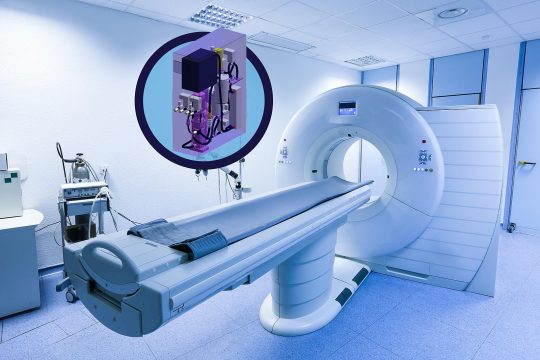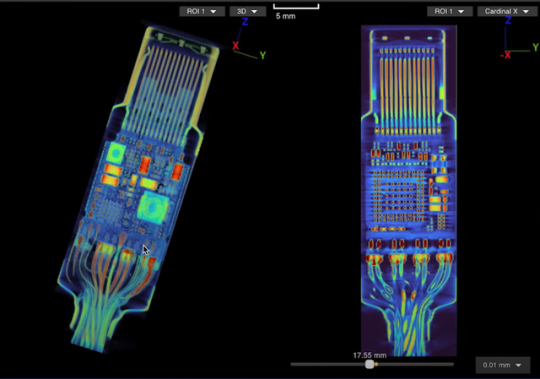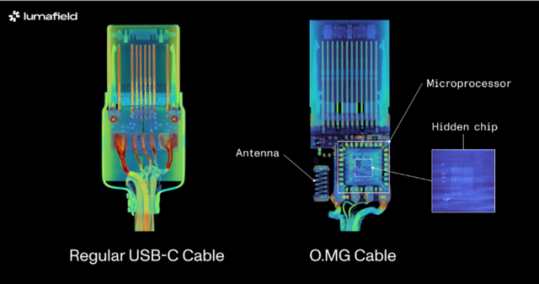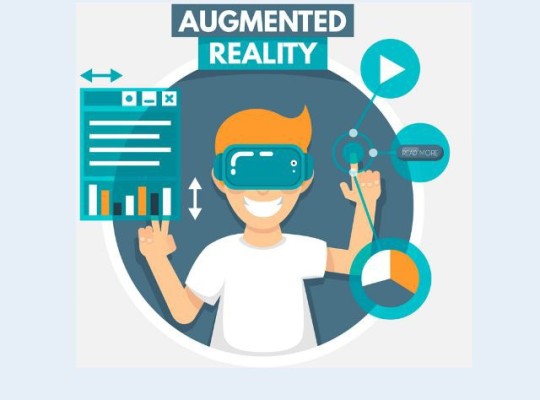#Medical Imaging Devices Market
Explore tagged Tumblr posts
Text
#Medical Imaging Devices Market#Medical Imaging Devices Market Size#Medical Imaging Devices Market Share
0 notes
Text
Global Medical Imaging Devices Market will grow at highest pace owing to increasing incidence of chronic diseases

Medical imaging devices such as X-ray devices, computed tomography (CT) scanners, magnetic resonance imaging (MRI) machines, ultrasounds, and nuclear imaging devices play a vital role in the diagnosis and treatment of various medical conditions. Medical imaging helps doctors examine the internal organs, tissues, bones, and other structures inside the human body. Some key advantages of medical imaging devices include their non-invasive nature, ability to detect abnormalities that may not be visible externally, and capacity to aid in interventional procedures. The growing global burden of chronic diseases such as cancer, cardiovascular diseases, neurological disorders, and more recently COVID-19, has propelled the demand for advanced medical imaging modalities for precise diagnosis and treatment monitoring purposes. The Global Medical Imaging Devices Market is estimated to be valued at US$ 40.33 Bn in 2024 and is expected to exhibit a CAGR of 6.2% over the forecast period 2023 to 2030. Key Takeaways Key players operating in the Global Medical Imaging Devices are Hitachi, Ltd., and Hologic Inc., Butterfly Inc., Analogic, and so on. Key players are investing in research and development activities to launch innovative imaging technologies. For instance, in 2023 Hitachi, Ltd. launched AI-assisted digital X-ray device that helps radiologists enhance diagnostic accuracy. The demand for medical imaging devices is growing significantly owing to increasing prevalence of chronic and lifestyle diseases, rising geriatric population, and rapidly evolving diagnostic imaging technologies. According to WHO, chronic diseases accounted for 71% of global deaths in 2019. The increasing disease burden is necessitating frequent medical scans which is propelling the demand for imaging equipment. Technological advancements are also fueling the market growth. Artificial intelligence and machine learning are enabling advanced applications of medical imaging like computer-assisted diagnosis and interventional guidance. Development of hybrid imaging systems integrating PET/CT and SPECT/CT with MRI is improving disease detection capabilities. Miniaturization of imaging devices is making point-of-care imaging possible. Market Trends 1. Multimodality imaging systems: hybrid imaging technologies integrating PET/CT, SPECT/CT, PET/MRI are gaining traction as they enable visualization of anatomical and physiological/molecular information simultaneously, enhancing diagnostic accuracy. 2. Personalized medical imaging: leveraging big data, AI and advanced analytics, providers are developing patient-specific imaging protocols and therapeutic strategies for better outcomes. Market Opportunities 1. Emerging economies in Asia Pacific and Middle East offer lucrative growth opportunities attributed to improving healthcare infrastructure, rapid economic development and growing medical tourism. 2. Point-of-care and portable imaging devices suitable for home healthcare, ambulatory care settings are opening new avenues backed by trend of decentralizing diagnostic care.
#Global Medical Imaging Devices Market Demand#Global Medical Imaging Devices Market Trend#Global Medical Imaging Devices Market Size
0 notes
Text
Diagnostic Imaging Services Market Driven by Rising Geriatric Population

Diagnostic imaging services refer to imaging tests such as X-rays, CT scans, MRIs, ultrasounds and nuclear medicine tests which help doctors diagnose and treat medical conditions. These services deliver anatomical and functional details of the human body that assists in identifying both acute and chronic conditions including cancer, cardiovascular diseases and orthopaedic disorders among others. The rising global burden of chronic diseases due to growing geriatric population and sedentary lifestyles has increased the demand for diagnostic imaging procedures worldwide.
The Global Diagnostic Imaging Services Market is estimated to be valued at US$ 787.55 Bn in 2024 and is expected to exhibit a CAGR of 5.7% over the forecast period 2024 to 2031. Key Takeaways Key players operating in the Diagnostic Imaging Services Market Growth are RadNet, Inc., Akumin Inc., Novant Health, RAYUS Radiology, MedQuest Associates, Concordmedical, Lucid Medical Diagnostics, Radiology Partners, Envision Radiology, Capitol Imaging Services, Statim Healthcare, InHealth Group, Global Diagnostic Imaging, an dADM Diagnostics, Inc. These companies are expanding their service offerings and global footprint through acquisitions and partnerships to leverage growth opportunities. The increasing demand for early disease detection and diagnosis is a major factor driving market growth. Diagnostic imaging allows medical practitioners to accurately diagnose conditions in their early stages, enabling timely intervention and effective treatment. This is expected to boost the uptake of diagnostic imaging procedures over the forecast period. The diagnostic imaging services market is also witnessing strong growth in emerging economies due to increasing investments by major market players. Leading companies are establishing diagnostic imaging centers in Asia Pacific and Latin America to tap the high-potential markets in these regions. Advanced healthcare infrastructure and rising medical tourism are facilitating the expansion of global players in developing markets. Market Drivers One of the key drivers fueling the diagnostic imaging services market is the growing geriatric population globally. Older individuals are more prone to developing chronic health conditions like cancer, cardiovascular diseases and neurological disorders. Since diagnostic images play a crucial role in disease diagnosis as people age, rapid population aging is expected to significantly drive the demand for diagnostic imaging procedures in the coming years. It is estimated that around 2 billion people will be aged 60 years and older by 2050. This demographic shift will continue creating high demand for diagnostic imaging technologies. The diagnostic imaging services market is facing various challenges due to the ongoing geopolitical changes across the world. The Covid-19 pandemic has severely impacted the healthcare sector which negatively affected the growth of this market. Reduced patient visits for preventive diagnostic checkups during the lockdowns hampered the market revenue. However, remote radiology practices and teleradiology solutions boosted growth as they help in delivering critical care for non-Covid patients. Nevertheless, the conflict between Russia and Ukraine also poses threats by disrupting supply chains and increasing raw material prices. This may hinder the procurement of advanced medical imaging equipment and limit market expansion.
To withstand such adversities, industry players need resilient supply chain management and should explore new raw material suppliers. They must adopt digital transformation initiatives like blockchain, AI, cloud and optimize operations through predictive analytics. This will make diagnostic workflows efficient while improving patient access to quality healthcare services. Regional collaborations should also be strengthened to expedite cross-border diagnostic tests. With stabilized geopolitics and ongoing medical innovations, the market is anticipated to recuperate and grow at a higher rate in the coming years. In terms of value, North America holds the largest share in the diagnostic imaging services market owing to advanced healthcare infrastructure, rising geriatric population and higher healthcare spending. The Asia Pacific region is poised to become the fastest growing market attributed to increasing investments by public and private players to modernize medical facilities, rising focus on preventive healthcare and growing medical tourism industry. Penetration of affordable diagnostic devices and solutions are stimulating the market growth across developing nations of Asia. Countries like India, China and Japan are rapidly transforming their healthcare infrastructure which would accelerate the APAC market expansion during the forecast period. The diagnostic imaging services market in Europe has substantial presence attributed to availability of reimbursement, technological innovations, skilled radiologists and established regulatory framework. However, the post-pandemic economic recovery in major European countries may impact market revenue in short-term due to budget constraints. Rest of the world region including Middle East, Africa and Latin America present lucrative opportunities for market stakeholders and are estimated to grow at a steady pace in upcoming years on back of infrastructure advancement, investments by emerging economies and healthcare reforms
Get More Insights On This Topic: Diagnostic Imaging Services Market
#Diagnostic Imaging Services Market#Diagnostic Imaging Services Market Size#Diagnostic Imaging Services Market Share#Diagnostic Imaging Services Market Analysis#Diagnostic Imaging Services#Healthcare#Medical Devices
0 notes
Text
Decoding Trends and Innovations in the Blood Cancer Diagnostics Industry
Blood cancer, a complex group of diseases affecting the blood, bone marrow, and lymphatic system, demands precise and efficient diagnostic tools. As advancements in medical technology continue to reshape the healthcare landscape, the Blood Cancer Diagnostics Market is witnessing dynamic changes. Let’s explore the key dynamics shaping this market. Advanced Testing Strategies in the Blood Cancer…

View On WordPress
#Blood Cancer#Blood Cancer Diagnostics#Blood Cancer Diagnostics Market#Blood Tests#Imaging Tests#Medical Device#Medical Devices Market#MedTech#MedTech Market#Molecular Tests
0 notes
Text
Navigating the Landscape: Unveiling the Diagnostic Imaging Market Trends and Challenges
In the ever-evolving realm of healthcare, diagnostic imaging has emerged as a cornerstone in disease detection, treatment planning, and monitoring. The Diagnostic Imaging Market, encompassing various facets such as medical imaging, diagnostic devices, and cutting-edge technologies, plays a pivotal role in shaping the landscape of modern healthcare. In this blog post, we will explore the nuances of the Diagnostic Imaging Market, delving into market trends, challenges, and the transformative impact of Artificial Intelligence (AI).
Market Size and Revenue:
The market size of the Diagnostic Imaging Industry continues to expand, driven by the growing demand for diagnostic services and an aging population. The global diagnostic imaging market size was estimated at US$ 28.12 billion in 2022 and is expected to hit US$ 51.55 billion by 2032, poised to grow at a noteworthy CAGR of 6.3% from 2023 to 2032. Increasing investments in healthcare infrastructure contribute to the overall revenue growth.

The Diagnostic Imaging Market Landscape:
The Diagnostic Imaging Market is a multifaceted domain that includes Medical Imaging, Diagnostic Imaging Devices, Diagnostic Equipment, and more. It involves a myriad of stakeholders, from manufacturers of diagnostic imaging devices to distributors of diagnostic medical imaging equipment.
Market Trends:
Integration of AI:
One of the most notable trends in the Diagnostic Imaging Market is the integration of Artificial Intelligence. AI has significantly enhanced the accuracy and efficiency of diagnostic procedures. With algorithms capable of analyzing complex medical images, AI is transforming the landscape by providing valuable insights and aiding in early disease detection.
Technological Advancements:
The market is witnessing constant technological advancements in diagnostic imaging devices. From more precise imaging modalities to portable and user-friendly equipment, manufacturers are investing in innovation to improve diagnostic capabilities and patient outcomes.
Growth in Veterinary Diagnostic Imaging:
The Diagnostic Imaging Market isn't confined to human healthcare alone. There is a noticeable surge in the Veterinary Diagnostic Imaging Market, reflecting the increasing importance of advanced imaging techniques in veterinary medicine.
Challenges in the Diagnostic Imaging Market:
High Costs:
While technological advancements are driving innovation, they also contribute to the rising costs of diagnostic imaging devices. Affordability remains a challenge, especially in regions with limited healthcare resources.
Regulatory Compliance:
Manufacturers and distributors face challenges in navigating complex regulatory frameworks. Meeting compliance standards and obtaining approvals for new diagnostic devices can be time-consuming and resource-intensive.
Rapid Technological Obsolescence:
The diagnostic imaging landscape evolves rapidly, leading to the potential obsolescence of existing technologies. Manufacturers must continually invest in research and development to stay competitive.
Data Security Concerns:
As diagnostic imaging becomes increasingly digital, concerns about data security and patient privacy emerge. Safeguarding sensitive medical information from cyber threats is a crucial challenge for the industry.
The Role of Research Reports:
Research reports on the Diagnostic Imaging Market offer invaluable insights into market dynamics, trends, and growth opportunities. These reports assist stakeholders in making informed decisions, guiding manufacturers, distributors, and investors in navigating the market landscape.
Conclusion:
The Diagnostic Imaging Market is a dynamic and integral part of modern healthcare, continuously evolving to meet the demands of an ever-changing landscape. As technology advances, challenges arise, and trends shape the future, stakeholders in the Diagnostic Imaging Industry must adapt to stay at the forefront of innovation, providing efficient and effective diagnostic solutions for improved patient care.
#Diagnostic Imaging Market#Medical Imaging Market#Diagnostic Imaging Devices Market#Diagnostic imaging device manufacturers#Diagnostic Imaging Market Trends
0 notes
Text
Evolving Trends And Strategies In The X-Ray Machine Manufacturing Market

In the dynamic landscape of medical technology, the X-Ray Machine Manufacturing Market is undergoing significant transformations driven by rapid advancements in technology and increasing demand for precise diagnostic equipment. This market plays a pivotal role in the healthcare industry, enabling accurate diagnoses and aiding medical professionals in making informed decisions. As the healthcare sector continues to evolve, so do the trends and strategies within themarket.
1. Technological Innovations Shaping the Market: In recent years, the X-Ray Machine Manufacturing Market has witnessed a surge in technological innovations. Traditional analog X-ray machines are giving way to digital radiography and computed tomography (CT) systems, which offer higher image quality, lower radiation doses, and faster imaging times. Moreover, the integration of artificial intelligence (AI) in X-ray interpretation is revolutionizing diagnostics. AI algorithms can swiftly analyze X-ray images, assisting radiologists in identifying abnormalities with greater accuracy. Manufacturers are investing heavily in research and development to stay at the forefront of these technological advancements, ensuring that their products remain competitive and align with healthcare's growing needs.
2. Focus on Patient Safety and Radiation Reduction: With an increasing emphasis on patient safety, radiation reduction has become a critical concern in the X-Ray Machine Manufacturing Market. Regulatory bodies and healthcare organizations are imposing stricter guidelines on permissible radiation doses. In response, manufacturers are developing X-ray machines that deliver exceptional image quality while minimizing radiation exposure. This trend not only safeguards patients and healthcare professionals but also expands the market's potential applications, such as pediatric and prenatal imaging.
3. Shift towards Portable and Point-of-Care Solutions: Another notable trend in the X-Ray Machine Manufacturing Market is the shift towards portable and point-of-care X-ray solutions. Traditional stationary X-ray machines are being complemented by portable devices that can be used at the patient's bedside or in remote locations. These devices are particularly valuable in emergency situations, where quick and accurate diagnoses are essential. Manufacturers are innovating to create lightweight, user-friendly, and cost-effective portable X-ray machines, addressing the demand for flexible and efficient healthcare solutions.
4. Global Market Expansion and Collaborative Strategies: As the demand for advanced healthcare services grows globally, the market is expanding its footprint across regions. Manufacturers are exploring strategic collaborations, partnerships, and acquisitions to tap into new markets and leverage local expertise. This approach helps them navigate regulatory hurdles, cultural nuances, and market preferences effectively. By forming alliances with distributors, healthcare facilities, and technology providers, manufacturers can ensure a wider reach and better integration of their products into diverse healthcare ecosystems.
In conclusion, the X-Ray Machine Manufacturing Market is experiencing a profound evolution driven by technological advancements, a focus on patient safety, the rise of portable solutions, and global market expansion strategies. Manufacturers who stay attuned to these trends and adapt their strategies accordingly are poised to not only thrive in the market but also contribute to enhancing healthcare outcomes. As the industry continues to push the boundaries of innovation, the future of X-ray machine manufacturing looks promising, with a positive impact on medical diagnostics and patient care.
#X-Ray Machine Manufacturing Market#Coherent Market Insights#X-Ray Technology#Medical Diagnostics#Healthcare Equipment#Radiography#Diagnostic Imaging#Medical Device Industry#Technological Innovation
0 notes
Text
Exploring the Advancements in CBCT Systems & its Impact on the Healthcare Industry

Cone Beam Computed Tomography (CBCT) is a type of medical imaging technology that uses X-rays to produce 3D images of the head, neck, and other parts of the body. The CBCT system market is growing as these systems provide detailed 3D images that help dental and maxillofacial specialists to diagnose and treat conditions with greater accuracy and precision, reducing the need for invasive procedures.
In addition to this, the CBCT systems are continuously evolving and becoming more sophisticated, which is driving growth in the market. Newer systems offer improved image quality, faster scan times, and lower radiation exposure for patients. Moreover, with increasing awareness about oral health and the link between oral health and overall health, people are becoming more conscious about their dental health, driving demand for CBCT systems.
Here are some of the key developments which took place in the global CBCT systems market in the recent years:
Companies have been investing in research and development to develop new and advanced CBCT systems that offer improved image quality and faster scan times, while reducing radiation exposure for patients.
Major players in the CBCT system market have been launching new and improved products to cater to the growing demand for digital dentistry and minimally invasive treatments.
Companies have been engaging in strategic mergers and acquisitions to expand their product portfolios, increase their market share, and strengthen their position in the market.
It's always a good idea to stay updated on the latest industry news and developments to have a better understanding of the market.
Some of the major market players include, Danaher Corporation, Planmeca Group, Carestream Health, Inc. (a subsidiary of Onex Corporation), Dentsply Sirona, Vatech Co., Ltd., J. Morita MFG. Corp, Cefla S.C., PreXion Corporation, Asahi Roentgen IND.CO., LTD., and CurveBeam LLC., amongst others.
Request Sample PDF: https://www.nextmsc.com/Cone-Beam-Computed-Tomography-System/request-sample
The COVID-19 pandemic has had an impact on the CBCT system market, just as it has affected many other industries. The pandemic has resulted in a decline in demand for CBCT systems due to the closure of dental clinics and suspension of non-emergency procedures. Furthermore, the pandemic has accelerated the shift towards telemedicine and virtual consultations, which has reduced the demand for CBCT systems as these systems are primarily used in on-site consultations.
Due to economic uncertainty caused by the pandemic, some dental clinics and healthcare facilities have reduced their investment in new equipment, including CBCT systems. Also, the pandemic has caused disruptions in the global supply chain, leading to shortages of raw materials and components used in the production of CBCT systems, impacting the availability of these systems.
However, it is anticipated that the demand for CBCT equipment would increase as the situation becomes better and dental offices and healthcare facilities get back to their regular schedules. In the near future, the market is anticipated to recover from the pandemic-caused slump.
In addition to this, there’re other factors which stand as roadblocks hindering its way of growth globally. For instance, CBCT systems are not widely available in all regions, which can limit access to this technology for some patients.
Also, CBCT scans expose patients to a relatively high radiation dose, which can raise concerns about potential long-term health effects. Again, the CBCT systems face competition from other imaging technologies, such as traditional radiography and magnetic resonance imaging (MRI), which can impact their market growth.
The Cone Beam Computed Tomography (CBCT) System market can be segmented based on several factors, including Applications, Detector Type, Field of View, End-User and Geography. These segmentations of the CBCT system market helps in better understanding the demand and supply dynamics, competitive landscape, and growth potential of various segments.
The Cone Beam Computed Tomography (CBCT) system market is a global market, with significant growth expected in regions such as North America, Europe, Asia-Pacific, and the Rest of the World. The growth in these regions can be attributed to factors such as increasing demand for advanced imaging technologies, growing aging population, and increasing prevalence of dental and oral diseases.
With the advancements in technology and increasing healthcare expenditure, the market is expected to continue its growth trajectory in the coming years.
About Us:
Next Move Strategy Consulting is an independent and trusted third-platform market intelligence provider, committed to deliver high quality, market research reports that help multinational companies to triumph over their competitions and increase industry footprint by capturing greater market share. Our research model is a unique collaboration of primary research, secondary research, data mining and data analytics.
We have been servicing over 1000 customers globally that includes 90% of the Fortune 500 companies over a decade. Our analysts are constantly tracking various high growth markets and identifying hidden opportunities in each sector or the industry. We provide one of the industry’s best quality syndicates as well as custom research reports across 10 different industry verticals. We are committed to deliver high quality research solutions in accordance to your business needs. Our industry standard delivery solution that ranges from the pre consultation to after-sales services, provide an excellent client experience and ensure right strategic decision making for business.
For more insights, please visit, https://www.nextmsc.com
#cbct dental imaging market#cbct#dentistry#dentalcare#medical devices#medication#patient care#healthcare industry
0 notes
Note
AITA for blackmailing someone and then snitching to the feds anyway? Okay, so I work for a contract medical research lab generating quantitative image data, working closely with veterinary pathologists who provide the qualitative data. Together, we put together a report like "okay, here's what the medicine/medical device did and here's why we think it happened", and that report usually gets sent to the FDA if it looks promising enough that the sponsor wants to push for clinical trials and eventual market release. So we get a study in and we've got (fake numbers here) 400 sections, but the quote says they only want 300 measurements done. I'm confused and go "wait, which 300 out of the 400? which 100 should I ignore?" and go to the pathologist. She also thinks it's weird and reaches out to the client, hoping it's a typo and we're about to get paid for the bonus 100. Nope! He pressures us for it to be a phone call (no paper trail) and then not-so-subtly hints that he wants the... uglier-looking sections dropped. In other words, he wants to cherry-pick data that makes him look good. This is not only dangerous but The Most Illegal Shit. People's lives hang in the balance and they have to be able to trust the research that tells them medicines and medical devices are safe. We take that responsibility seriously. So the pathologist gathers data and emails him like "I'm taking a REPRESENTATIVE 300 samples for analysis, my report will include scoring of the ones that make you look bad, and if I find out you doctored the reports behind my back, I'm sending everything I have directly to the FDA." (this is not how data is normally submitted in the industry. normally the report is commissioned, and then all dealings with the FDA are done by the client) He grouses, but agrees. And then says "if the FDA reaches out to you, don't respond." .....What? But that's already industry standard? Why would he say that? Why would he expect the FDA to reach out to us? Anyway the pathologist and I discuss it, and both assume he's definitely about to doctor these reports behind our back once it's submitted. So at my suggestion... the pathologist sends the communications to the FDA anyway. Here's the thing: we don't actually know that this guy meant to do some ethics violations. We just assumed he was suspicious without real proof. Even unproven accusations in this industry can get you blacklisted for life, if not facing criminal charges. Did we risk destroying some random guy's life over bad vibes and nothing else?
What are these acronyms?
113 notes
·
View notes
Text
How to know if a USB cable is hiding malicious hacker hardware
Are your USB cables sending your data to hackers?

We expect USB-C cables to perform a specific task: transferring either data or files between devices. We give little more thought to the matter, but malicious USB-C cables can do much more than what we expect.
These cables hide malicious hardware that can intercept data, eavesdrop on phone calls and messages, or, in the worst cases, take complete control of your PC or cellphone. The first of these appeared in 2008, but back then they were very rare and expensive �� which meant the average user was largely safeguarded.
Since then, their availability has increased 100-fold and now with both specialist spy retailers selling them as “spy cables” as well as unscrupulous sellers passing them off as legitimate products, it’s all too easy to buy one by accident and get hacked. So, how do you know if your USB-C cable is malicious?
Further reading: We tested 43 old USB-C to USB-A cables. 1 was great. 10 were dangerous
Identifying malicious USB-C cables
Identifying malicious USB-C cables is no easy task since they are designed to look just like regular cables. Scanning techniques have been largely thought of as the best way to sort the wheat from the chaff, which is what industrial scanning company, Lumafield of the Lumafield Neptune industrial scanner fame, recently set out to show.
The company employed both 2D and 3D scanning techniques on the O.MG USB-C cable — a well-known hacked cable built for covert field-use and research. It hides an embedded Wi-Fi server and a keylogger in its USB connector. PCWorld Executive Editor Gordon Ung covered it back in 2021, and it sounds scary as hell.
What Lumafield discovered is interesting to say the least. A 2D X-ray image could identify the cable’s antenna and microcontroller, but only the 3D CT scan could reveal another band of wires connected to a die stacked on top of the cable’s microcontroller. You can explore a 3D model of the scan yourself on Lumafield’s website.

It confirms the worst — that you can only unequivocally confirm that a USB-C cable harbors malicious hardware with a 3D CT scanner, which unless you’re a medical radiographer or 3D industrial scientist is going to be impossible for you to do. That being so, here are some tips to avoid and identify suspicious USB-C cables without high-tech gear:
Buy from a reputable seller: If you don’t know and trust the brand, simply don’t buy. Manufacturers like Anker, Apple, Belkin, and Ugreen have rigorous quality-control processes that prevent malicious hardware parts from making it into cables. Of course, the other reason is simply that you’ll get a better product — 3D scans have similarly revealed how less reputable brands can lack normal USB-C componentry, which can result in substandard performance. If you’re in the market for a new cable right now, see our top picks for USB-C cables.
Look for the warning signs: Look for brand names or logos that don’t look right. Strange markings, cords that are inconsistent lengths or widths, and USB-C connectors with heat emanating from them when not plugged in can all be giveaways that a USB-C cable is malicious.
Use the O.MG malicious cable detector: This detector by O.MG claims to detect all malicious USB cables.
Use data blockers: If you’re just charging and not transferring data, a blocker will ensure no data is extracted. Apart from detecting malicious USB-C cables, the O.MG malicious cable detector functions as such a data blocker.
Use a detection service: If you’re dealing with extremely sensitive data for a business or governmental organization, you might want to employ the services of a company like Lumafield to detect malicious cables with 100 percent accuracy. Any such service will come with a fee, but it could be a small price to pay for security and peace of mind.
12 notes
·
View notes
Text
#Medical Imaging Devices Market#Medical Imaging Devices Market Share#Medical Imaging Devices Market Size
0 notes
Text










"Britney Spears knows what it's like to feel trapped: First by poverty, then by fame, then by her family.
She has been subject to scrutiny and ridicule throughout her life. As a teenager, journalists repeatedly asked her questions about her breasts and her sex life. As an adult, she was imprisoned under a conservatorship that stripped her of some of the most basic human rights.
For 13 years, she could not see her two sons without approval. Her driving licence was confiscated. She could not choose her meals, and was forbidden from drinking tea or coffee. When she wanted to have a contraceptive intrauterine device (IUD) removed, her request was denied.
That court-imposed order, overseen by her father, was lifted two years ago, when a judge ruled Spears could make her own decisions again.
But her new memoir, The Woman In Me, reveals that was no happy ending...
Those events cast a shadow over Spears' life story. Along the way, every betrayal and public indignity feels like a step along the path to her eventual incarceration.
It began as soon as she exploded onto the pop charts in 1998. She was an overnight sensation, but the press refused to believe she had any agency. Her songs were written for her, they noted, while suggesting that her public image was created by creepy, salivating older men.
The more she was perceived as a product and a pawn of the music industry, the easier it became to erode her autonomy.
In one of the book's most chilling moments, Spears recalls her father telling her he's assumed legal control of her personal and professional affairs.
His words: "I am Britney Spears now."
The early chapters of the book stress how much people underestimated her.
Spears may not have written her music - but when she was given ...Baby One More Time, she stayed up all night to make sure her voice was "fried, and "gravelly", enhancing the song's yearning maturity.
And when it came to shooting the video, the 16-year-old rejected the original pitch - in which she'd have been "a futuristic astronaut " - and insisted on a high school setting with dancing in the corridors, just like Grease.
Both decisions were crucial to the song's success - but no-one was willing to accept a blonde teenager from a Louisiana trailer park could outsmart the collective brilliance of the music industry.
"No-one could seem to think of me as both sexy and capable," she writes. "If I was hot, I couldn't possibly be talented."
Although she exercised creative control behind the scenes, Spears' publicists infantilised her.
She was marketed as a chaste, God-fearing country girl - even though, she writes, she had been a regular smoker since the age of 14 and lost her virginity around the same time.
At first, however, she toed the PR line...
Eventually, however, Spears' innocent image set her up for a downfall.
In one of the book's most harrowing sequences, she talks about having a medical abortion during her relationship with Justin Timberlake. The pills she had been prescribed left her in agony but the couple were too scared to visit a hospital in case the news leaked. For hours, Spears was curled up, "sobbing and screaming" in pain on the bathroom floor.
"Still, they didn't take me to hospital," she says. Instead Timberlake, "thought music would help, so he got his guitar and lay there with me, strumming it."...
After their separation, she was vilified in the press, with Timberlake strongly hinting she had cheated on him (she says it was the other way round, with "one of the girls from All Saints").
Timberlake has yet to respond to his depiction in the book.
The couple's break-up only increased the appetite for gossip about Spears' personal life. The tabloids hounded her. She recalls a photographer from People magazine demanding she empty her handbag, so they could check whether she was carrying drugs or cigarettes.
Eventually, the pressure became too much. In 2007, reeling from the death of her aunt Sandra and suffering from post-partum depression, Spears marched into a hair salon, picked up some clippers and cut off her hair.
"Shaving my head was a way of saying to the world: [Expletive] you," she writes.
"I'd been the good girl for years. I'd smiled politely while TV show hosts leered at my breasts, while American parents said I was destroying their children by wearing a crop top. And I was tired of it."
We all know what happened next. Instead of being seen as an act of strength or rebellion, Spears' buzz-cut was used as evidence of instability.
Within a year, she had been placed under the conservatorship.
Spears is a straightforward writer. She doesn't embellish or decorate her prose. That matter-of-fact style amplifies the horror of those years.
She talks about being pinned down on hospital stretchers and forced to take medication against her will. At home, she isn't allowed to take a bath in private. Boyfriends are vetted and informed of her sexual history before they can go on a date.
At first, she tries to appease her parents and the doctors. "If I play along, surely they'll see how good I am and they will let me go," she says.
When she considers rebelling, access to her two young sons is used as a bargaining chip.
"My freedom in exchange for naps with my children... was a trade I was willing to make," she admits.
But even while she was supposedly incapable of looking after herself, Spears was sent out on tour, hired as a judge on X Factor and booked for a four-year Las Vegas residency.
The singer, who used to collect receipts in a glass bowl in order to keep track of her taxes, carefully documents the millions everyone else made from those engagements, while she was given a strict allowance of $2,000 (£1,635) per week.
Losing all sense of self, she almost gave up.
"The fire inside me burned out," she recalls. "The light went out of my eyes." ...
It's impossible to read The Woman In Me and not feel sad and outraged on Spears' behalf.
One tiny detail of her new life, in particular, emphasises how grey her world had become. "Now," she writes, "I get to eat chocolate again".
Spears' story is told with the same approachable warmth that made her a star. And, outside the defining events of the last 15 years, she spins a good yarn - whether describing her pregnancy cravings (food and sex, apparently); or reliving her terror at dancing with a snake at the 2001 MTV Awards.
Her family aside, there are no real villains or scandals to be uncovered. But nor are there any great revelations about Spears' music or inner life.
What we are left with, not for the first time, is a cautionary tale about fame and the corrupting influence of money. And, just maybe, a glimmer of hope for a woman whose adult life has been dictated by others.
"It's time for me not to be someone who other people want," she writes. "It's time to actually find myself."
#Britney spears#Britney#feminism#mental health#conservatorship#conservatorship abuse#justin timberlake#kevin federline#2000s#1990#90s#the woman in me#bbc#free britney#women's rights
64 notes
·
View notes
Text
Top Futuristic AI Based Applications by 2024
2024 with Artificial Intelligence (AI) is the backdrop of what seems to be another revolutionary iteration across industries. AI has matured over the past year to provide novel use cases and innovative solutions in several industries. This article explores most exciting AI applications that are driving the future.
1. Customized Chatbots
The next year, 2024 is seeing the upward trajectory of bespoke chatbots. Google, and OpenAI are creating accessible user-friendly platforms that enable people to build their own small-scale chatbots for particular use cases. These are the most advanced Chatbots available in the market — Capable of not just processing text but also Images and Videos, giving a plethora of interactive applications. For example, estate agents can now automatically create property descriptions by adding the text and images of listings thatsurgent.
2. AI in Healthcare

AI has found numerous applications in the healthcare industry, from diagnostics to personalized treatment plans. After all, AI-driven devices can analyze medical imaging material more accurately than humans and thus among other things help to detect diseases such as cancer at an early stage. They will also describe how AI algorithms are used to create tailored treatment strategies personalized for each patient's genetics and clinical past, which helps enable more precise treatments.
3. Edge AI
A major trend in 2024 is Edge AI It enables computer processing to be done at the edge of a network, rather than in large data centers. Because of its reduced latency and added data privacy, Edge AI can be used in applications like autonomous vehicles transportations, smart cities as well as industrial automation. Example, edge AI in autonomous vehicles is able to get and process real-time data, increasing security by allowing faster decision-making.
4. AI in Finance

Today, the financial sector is using AI to make better decisions and provide an even stronger customer experience. Fraud detection, risk assessment and customised financial advice have introduced insurance into the AI algorithm. AI-powered chatbots and virtual assistants are now common enough to be in use by 2024, greatly assisting customers stay on top of their financial well-being. Those tools will review your spending behavior, write feedback to you and even help with some investment advices.
5. AI in Education
AI is revolutionizing education with individualized learning. These AI-powered adaptive learning platforms use data analytics to understand how students fare and produces a customised educational content (Hoos, 2017). This way, students get a tailored experience and realize better outcomes. Not only that, AI enabled tools are also in use for automating administrative tasks which shortens the time required by educators on teaching.
6. AI in Job Hunting

This is also reverberating in the job sector, where AI technology has been trending. With tools like Canyon AI Resume Builder, you can spin the best resumé that might catch something eye catchy recruiter among a dozen others applications he receives in-between his zoom meeting. Using AI based tools to analyze Job Descriptions and match it with the required skills, experience in different job roles help accelerating the chances of a right fit JOB.
7. Artificial Intelligence in Memory & Storage Solutions
Leading AI solutions provider Innodisk presents its own line of memory and storage with added in-house designed AI at the recent Future of Memory & Storage (FMS) 2024 event. Very typically these are solutions to make AI applications easier, faster and better by improving performance scalability as well on the quality. This has huge implications on sectors with substantial data processing and storage demands (healthcare, finance, self-driving cars).
Conclusion

2024 — Even at the edge of possible, AI is revolutionizing across many industries. AI is changing our lives from tailored chatbots and edge AI to healthcare, finance solutions or education and job search. This will not only improve your business profile as a freelancer who create SEO optimized content and write copies but also give your clients in the writing for business niche some very useful tips.
#ai#ai in healthcare#ai in finance#ai in wealth management#ai in business#AI trends#artificial intelligence#advanced technologies#innovation#technological advancements
4 notes
·
View notes
Text
Unlocking the Potential: Emerging Players in Blood Cancer Diagnostics
Blood cancer, a complex group of diseases affecting the blood, bone marrow, and lymphatic system, demands precise and efficient diagnostic tools. As advancements in medical technology continue to reshape the healthcare landscape, the Blood Cancer Diagnostics Market is witnessing dynamic changes. Let’s explore the key dynamics shaping this market. Advanced Testing Strategies in the Blood Cancer…

View On WordPress
#Blood Cancer#Blood Cancer Diagnostics#Blood Cancer Diagnostics Market#Blood Tests#Imaging Tests#Medical Device#Medical Devices Market#MedTech#MedTech Market#Molecular Tests
0 notes
Text
The Rise of Augmented Reality in Everyday Life
Augmented Reality (AR) is a transformative technology that superimposes digital information onto the real world, enhancing our perception of reality. Unlike Virtual Reality (VR), which creates an entirely immersive virtual environment, AR overlays digital elements—such as images, sounds, or text—onto our physical surroundings using devices like smartphones, tablets, or AR glasses.

Present-day Uses of AR Augmented reality (AR) is altering how we interact with technology and the world around us by making substantial breakthroughs across multiple fields.
Retail: AR is being used by retailers to improve the in-store experience. Customers may see how makeup, accessories, and clothing will appear on them without having to visit a store by using virtual try-on apps. One example is the AR app from IKEA, which allows users to see how furniture would fit and appear in their houses.
Healthcare: AR is being used in healthcare to help with medical training and complicated procedures. During procedures, surgeons can access real-time data and 3D organ renderings with AR glasses, which will increase accuracy and improve results.
Education: By increasing interaction and engagement, augmented reality is revolutionizing the way people learn. By allowing students to investigate 3D replicas of historical sites, the solar system, or anatomical structures, they may make abstract ideas come to life.
Entertainment: AR has been warmly welcomed by the entertainment sector. Augmented reality (AR) is giving consumers new experiences in everything from immersive movie advertising to apps like Pokémon Go that mix virtual characters with actual locales.

Improving Social Media and Mobile App User Experiences AR features are being added to mobile apps and social media platforms more often to draw consumers in. AR filters are a feature of Instagram and Snapchat that enhance images and videos with fun, animated effects, encouraging user creativity and interaction. With the use of augmented reality (AR) apps like Google Lens, users can quickly get information about items, landmarks, and other subjects by pointing the camera of their phone at objects.
Effects on Marketing and Advertising Plans Through the creation of immersive, interactive campaigns that grab consumers' attention, augmented reality is transforming marketing and advertising. Through gamified marketing, interactive advertisements, and virtual product demos, brands are utilizing augmented reality to increase engagement and conversion. For instance, Pepsi's augmented reality bus stop campaign left a lasting impression by delighting onlookers with lifelike digital animations.

Prospects & Development Trends for AR in the Future The development of augmented reality (AR) is expected to continue due to ongoing technological developments. AR experiences will be improved, becoming more smooth and accessible with advancements in AR glasses, computing power, and AI integration. We may anticipate that augmented reality (AR) will revolutionize a number of businesses and how we communicate with one another.

Conclution The emergence of augmented reality is evidence of the infinite applications of technology. AR is changing our daily experiences in a variety of ways, from improving healthcare and retail to transforming education and entertainment. As augmented reality develops, it promises to usher in a day where the virtual and real worlds coexist peacefully, presenting countless chances for creativity and interaction.
2 notes
·
View notes
Text
Exploring the Latest Breakthroughs in Technology
Introduction
Technology is evolving at a rapid pace, bringing with it groundbreaking innovations that are reshaping our world. From artificial intelligence to renewable energy solutions, these advancements are enhancing our lives in ways we never imagined. In this article, we'll explore some of the most exciting recent breakthroughs in technology that are set to transform various industries and everyday life.
1. Artificial Intelligence and Machine Learning
Artificial Intelligence (AI) and Machine Learning (ML) are at the forefront of technological innovation. AI and ML are being integrated into a myriad of applications, from healthcare diagnostics to personalized marketing. These technologies analyze vast amounts of data to make predictions, automate processes, and provide valuable insights.
AI in Healthcare
AI is revolutionizing healthcare by improving diagnostic accuracy and patient care. Machine learning algorithms can analyze medical images to detect diseases like cancer at early stages, enabling timely treatment and better patient outcomes.
AI in Everyday Life
In our daily lives, AI powers virtual assistants like Siri and Alexa, enhances customer service through chat-bots, and personalizes our online shopping experiences. The continuous improvement of AI algorithms is making these applications smarter and more efficient.
2. Quantum Computing
Quantum Computing promises to solve problems that are currently insurmountable for classical computers. By leveraging the principles of quantum mechanics, quantum computers perform complex calculations at unprecedented speeds.
Advancements in Cryptography
Quantum computing has the potential to revolutionize cryptography by breaking encryption codes that secure our digital communications. This breakthrough necessitates the development of new cryptographic methods to protect sensitive information.
Applications in Drug Discovery
In the pharmaceutical industry, quantum computing can simulate molecular interactions at a granular level, accelerating the drug discovery process and leading to the development of new, effective medications.
3. Renewable Energy Technologies
The shift towards renewable energy technologies is crucial in combating climate change. Innovations in solar, wind, and battery technologies are making renewable energy more efficient and accessible.
Solar and Wind Energy
Recent advancements in solar panel efficiency and wind turbine design are increasing the amount of energy harvested from natural sources. These improvements are making renewable energy a viable alternative to fossil fuels.
Energy Storage Solutions
Enhanced battery technologies are crucial for storing renewable energy, ensuring a consistent power supply even when the sun isn't shining or the wind isn't blowing. Breakthroughs in battery capacity and lifespan are driving the adoption of renewable energy systems.
4. Internet of Things (IoT)
The Internet of Things (IoT) connects devices and systems, enabling them to communicate and share data. This connectivity is transforming homes, industries, and cities into smarter, more efficient environments.
Smart Homes
IoT technology is making homes smarter by automating lighting, heating, and security systems. Smart home devices can be controlled remotely, offering convenience and energy savings.
Industrial IoT
In industrial settings, IoT devices monitor equipment health and optimize manufacturing processes. Predictive maintenance enabled by IoT sensors can reduce downtime and improve efficiency.
5. Blockchain Technology
Blockchain is revolutionizing how we handle transactions and data security. This decentralized ledger technology ensures transparency and security in various applications.
Financial Transactions
Blockchain is streamlining financial transactions by eliminating the need for intermediaries. It provides a secure and transparent way to transfer funds and verify transactions.
Supply Chain Management
In supply chains, blockchain offers traceability and transparency, reducing fraud and ensuring the authenticity of products. This technology is particularly beneficial in industries like pharmaceuticals and food.
6. 5G Technology
The roll-out of 5G technology is set to enhance connectivity with faster speeds and lower latency. This advancement will support the growth of IoT, autonomous vehicles, and smart cities.
Enhanced Mobile Connectivity
5G technology promises to improve mobile experiences with seamless streaming and quick downloads. It will also enable new applications in virtual and augmented reality.
Smart Cities
5G will facilitate the development of smart cities, where real-time data exchange enhances urban management systems, traffic control, and emergency services.
7. Autonomous Vehicles
Autonomous vehicles are set to transform transportation. Advances in AI and sensor technology are bringing self-driving cars closer to reality, offering safer and more efficient travel options.
Safety and Efficiency
Autonomous vehicles can reduce accidents caused by human error and optimize traffic flow, reducing congestion and emissions. They hold the potential to revolutionize the logistics and delivery sectors.
Delivery Services
Self-driving delivery vehicles and drones are making logistics faster and more reliable. These innovations are particularly beneficial in urban areas, where they can reduce traffic and pollution.
8. Biotechnology
Biotechnology is advancing rapidly, offering solutions in healthcare, agriculture, and environmental management. Innovations in gene editing, synthetic biology, and bio-engineering are opening new possibilities.
Gene Editing
CRISPR technology is enabling precise gene editing, offering potential cures for genetic diseases and innovations in agriculture. This technology is paving the way for new treatments and sustainable farming practices.
Synthetic Biology
Synthetic biology is creating new biological systems and organisms, leading to advancements in medicine, bio-fuels, and sustainable materials. This field holds promise for addressing global challenges such as disease and climate change.
9. Augmented Reality (AR) and Virtual Reality (VR)
AR and VR technologies are providing immersive experiences in entertainment, education, and various professional fields. These technologies are creating new ways to interact with digital content.
Gaming and Entertainment
AR and VR are enhancing gaming experiences by creating immersive environments and interactive game-play. These technologies are also being used in movies and virtual concerts, offering new forms of entertainment.
Professional Training
In education and professional training, AR and VR offer realistic simulations for hands-on learning. Fields like medicine, engineering, and aviation benefit from these technologies by providing safe and effective training environments.
Conclusion
The latest breakthroughs in technology are driving significant changes across various sectors. From AI and quantum computing to renewable energy and autonomous vehicles, these innovations are shaping the future and improving our lives. Staying informed about these developments is crucial for individuals and businesses alike to leverage the benefits of these technological advancements. As we look to the future, these game-changing technologies will continue to evolve, offering new opportunities and solutions to the challenges we face.
#technology#artificial intelligence#virtual reality#immersive technology#renewableenergy#ai algorithm#valuable insights#internet of things#technological advancements
2 notes
·
View notes